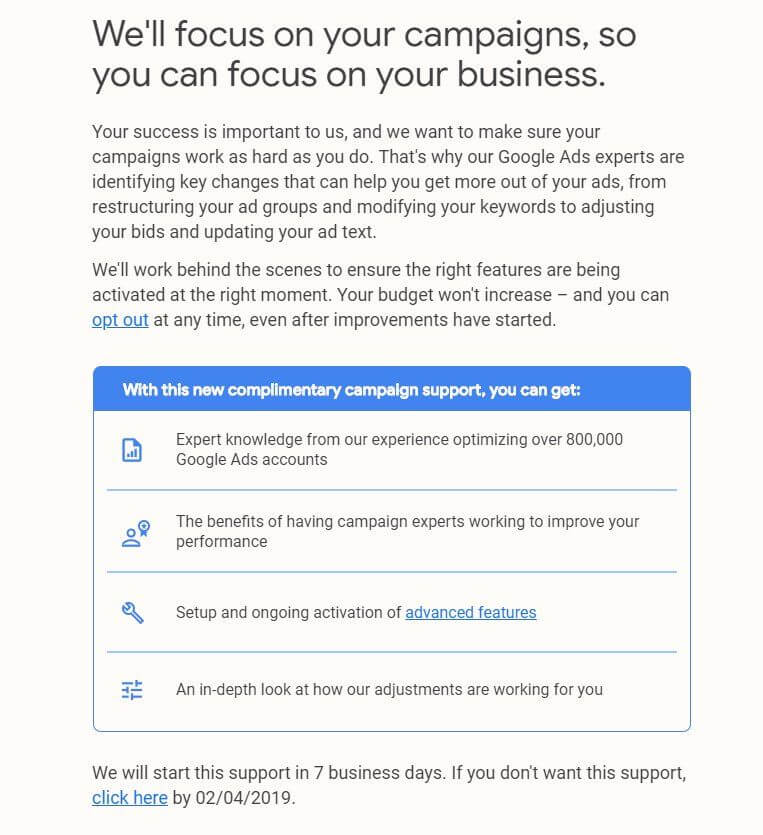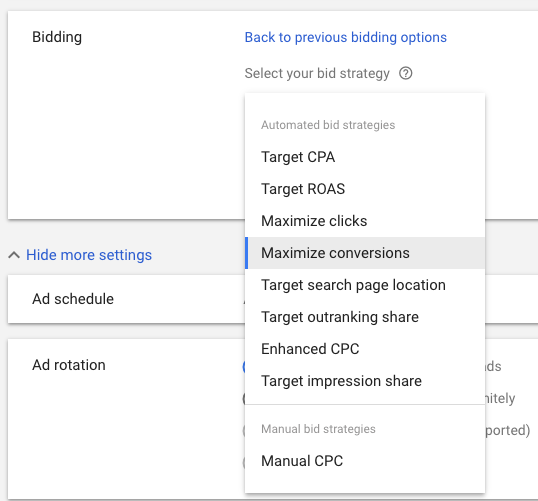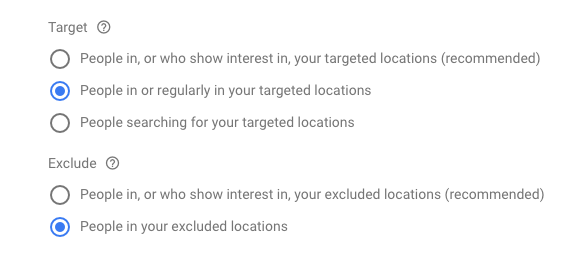5 Default Google Ads Campaign Settings To Change Right Now
Google is continually updating its Google Ads platform and it’s important to stay up-to-date with the latest changes so you can be sure you’re in control of your ads. With these constant changes, it can be difficult to stay in the know, but our search engine marketing experts attends training to stay on top of the latest strategies. We learned some great insights during our most recent training, and we’re excited to share them with you!
While you might think the default settings in Google Ads are there to help businesses reach their goals, many settings primarily generate revenue for Google. Below are five tips our team members learned at our most recent Google Ads training that you need to implement in your Google Ads campaigns right now.
Tip #1: Don’t Let Google Run Your Google Ads Campaigns
Google recently sent emails to advertisers with the headline “We’ll focus on your campaigns so you can focus on your business.” It sounds nice, right? Think again. Google is bringing “Google Ads experts” to manage advertisers’ campaigns with the disclaimer that doing so “doesn’t guarantee or promise any particular results from implementing these changes.” This happens automatically unless you click the link from the email to opt out. Default management from Google may not be best for your brand because Google doesn’t know your specific goals and what drives revenue for your business. Below is a screenshot of the email advertisers received discussing these changes.

Tip #2: Decide If Your Ad Campaign Makes Sense In Search Or Display
When you create a Google Ads campaign, you’ll begin by deciding if you want to run a Search or Display campaign. If you choose Search, Google checks the box that says “Include Google Display Network” by default. Make sure this is not selected! Search campaigns should always be separate from Display campaigns because the goals for each are unique. The Display network is specifically for image or video-based campaigns. Text ads tend to be overlooked when run on the Display Network, leading to fewer quality clicks and wasted ad spend—not ideal for driving conversions. For best results, keep your Search and Display campaigns separate.

Tip #3: Automated Versus Manual Bidding
One of the first choices you will make when setting up your Google Ad Campaign is which bidding strategy to choose. You have the option of selecting an automated bid strategy such as maximize conversions or selecting the manual CPC (cost-per-click) option. If you’re going to be pausing and restarting your Google Ad campaign for any reason at all, you should select the manual CPC option.
Why does this matter? If you select an automated bidding strategy, Google’s machine learning starts from scratch each time you turn your campaign back on. Any data previously accumulated is no longer utilized and conversion optimizations are lost. In addition, if you have multiple conversions and no dollar amounts defined, automated bidding strategies will treat all of your conversions as equal unless you adjust the settings. A page load is rarely as valuable as form completion, but if you have not specifically indicated this, Google will weight them evenly for automated bidding. We recommend the manual CPC bid strategy because it allows you the ability to control campaigns based on your marketing goals.

Tip #4: Select Keyword Match Types That Makes Sense For Your Google Ads Campaign
When you create a Google Ads campaign and input your keywords, you select which keyword match types will trigger your ads when searched. There are four different keyword match types: broad, modified broad, phrase, and exact. There are also keyword match types for negative keywords or keywords for which you do not want your ads to show. At Blue Compass, we use a variety of match types to catch the searches we want to appear for.
Typically, we recommend avoiding broad match keywords because they are too general. Instead, we choose our top queries and create a modified broad, exact match and phrase match keyword for each query. Not sure what each match type means? Below we’ve outlined the different match type definitions and provided examples of when you should utilize each keyword match type.
Broad Match
What Is The Broad Match Type?
Broad match is the default match type for keywords. Ads are triggered by related searches which include your broad match keyword, including misspellings. This match type is the most general. Google gives an example of “women’s hats” being a broad match keyword that would trigger ads for searches such as “buy ladies hats” or “blue baseball hats.”
When Should I Use The Broad Match Type?
If your main objective is impressions, broad match keywords may be in your best interest since it casts the widest net. However, with casting such a wide net, you may not be putting your ad in front of your most ideal audience. This can waste your ad spend and increase your cost-per-click, leading to high impressions and low click-through rate (CTR) on your ad.
Using a negative-broad match keyword will ensure your ad will not be triggered when any part of your keyword phrase is present. While broad-match is the most general for regular keywords, when applied to negative keywords it is the most limiting.
Broad Match Modifier
What Is The Broad Match Modifier Type?
Broad match modifier is similar to the broad match type except you can specifically identify which keywords must be included in a search query to trigger your ad. The plus sign (+) is used to indicate which words must be present, so your keyword “+digital marketing” will trigger for searches of digital marketing or digital media, but not just marketing. Google gives the example of women's hats triggering ads for "women's scarves and hats" and "winter hats for women." This is a much safer match type that doesn’t allow Google to extend its reach past the keywords you are selecting.
When Should I Use Broad Match Modifier?
The broad match modifier type is the second most broad match type and should be utilized when you’re okay with Google triggering your ad for anything it deems as a close variation. It’s a relatively broad match type and is a top of the funnel marketing strategy.
Phrase Match
What Is Phrase Match?
Phrase match triggers ads for the exact phrase and includes searches which have words before or after the phrase match keyword. Google gives the example of the keyword “adopt a kitten” triggering an ad if a person searched for “how to adopt a kitten”. To indicate phrase match keywords use quotation marks around your phrase.
When Should I Use Phrase Match?
Phrase match places great importance on the order of the keywords, so you should use this match type if it’s important to your business. For example, if your shoe store sells only running shoes, not all types of shoes, phrase match will ensure you are filtering out searches like high-heeled shoes. If you use a negative phrase-match keyword, your ad would not be triggered if the searcher uses the keywords in the same order as yours.
Exact Match
What Is Exact Match?
Exact match keywords show ads for the exact phrase you indicate or close variations with a very similar intent to the keyword. Google gives the example of a keyword, “running shoes” that would trigger an ad if a searcher inquired for “shoes for running.” Unlike phrase match, exact match keywords will not serve ads when someone searches for your keyword with words before or after, so searches for “red and black running shoes” would not trigger an ad. To indicate exact match keywords use brackets around your phrase.
When Should I Use Exact Match?
Exact match gives you the most control over which keywords trigger your ad, resulting in a higher click-through rate compared to other match types. If you use a negative exact-match keyword, then your ad will only show up if the exact words are used in the order you specify. This gives advertisers the most control of the keywords that trigger your ad.
Tip #5: Google Ads Location Targeting
Odds are that your current Google Ads location targeting is not optimal for your business. In Google Ads, the location default is set to “people in, or who show interest in, your targeted locations.” With this option, someone from another country can search Google for your local barbecue restaurant and trigger your ad even if they have no intentions of visiting. If the person from another country previously searched for anything related to the USA, such as news, they’re considered “interested.” This doesn’t make sense for most advertisers. If you select “People in or regularly in your targeted locations” only the specific locations you designate will receive your ad with their search queries along with commuters that are often in that location. The only exception to this targeting rule is if you are specifically targeting people from out of town to visit your destination, like a hotel.

For those that already have their Google Ads campaign up and running, you can still update these settings. You can click on “Location” on the left side of your campaign. From there, you can see which locations you’re currently targeting, which ones are excluded and see a geographic report at the top of the page. We recommend analyzing this report and then making adjustments to your location campaign settings.

.png)
What Happened When We Implemented These Changes To Our SEM Campaigns?
Once we learned about some of these Google Ads setting changes we should be making, we put together a plan to adjust these as quickly as possible. We started with a client account whose search campaigns continually perform well, but we found that even a successful account has room for improvement. So what exactly did we do to earn better SEM results?
- Changed all Automated or Enhanced settings to Manual to take the control back from Google. We know our client’s goals better than Google does, so we wanted to be in charge of as many decisions as possible.
- Chose more strategic match types for all keywords instead of using broad match. Our team was already doing this on a regular basis, but we took time to really taper down the list. This helped us appear for more intentional searches that coincide with our SEM goals.
- Specified our location settings so we only appeared to people who are in or frequently within our target location areas.
- Tailored our ad copy to match the specific queries and keywords we were trying to appear for, to help improve clicks and click through rate (CTR).
Analyzing The Results
This overhaul to our client’s account took place between February 8-10. You can see exactly when we started taking the lead in mid-February - where the clicks and costs went down while the click-through-rates increased and conversion rates skyrocketed. After a couple months, we compared our January and March data to see the differences. Since our overhaul took place in the middle of February, we expected the results for that month to be a bit skewed.

When we compared a full month with our old settings (January) versus a month with our updated settings and best practices (March), we saw some drastic differences! The biggest takeaways our team learned from this experiment:

- Our client spent $400 less than average. This was a result of our impressions and clicks decreasing dramatically due to reaching only quality users. Even though some marketers would say less clicks isn’t a good thing, in this case it was very beneficial to the client. Lower clicks and impressions meant they weren’t wasting money on clicks that weren’t turning into leads.
- Our click-through-rate (CTR) increased by 58.5% compared to the previous period. By taking back control and making changes to ensure we were showing our ads to a quality audience, our team could ensure that the people who would see our Google Ads in search results were looking to purchase the service our client provided. Our CTR of 6.5% is well above the industry average, and 2.4% higher than it was in January.
- Our conversion rate from Google Ads doubled. The goal of many of these changes was to fine-tune our ad groups, keywords and ads to match specific searches that matched the intent of our client’s goals. This meant our ads wouldn’t show to a broad spectrum of people anymore, but they would appear only to the users who were most likely to click and convert. After our changes, our conversion rate soared to 25.2%, meaning 1 in 4 people that came to our client’s website from a Google Ad converted.
- We earned almost the same number of conversions while spending far less. Despite earning half as many clicks back to the website, it didn’t really harm our end goal of getting conversions for our client.
These metrics show that Google doesn’t know our clients as well as we do. This isn’t a surprise, but it should convince some digital marketers that taking the easy way out and letting Google’s automatic and enhanced settings choose what’s best for your campaign may not be in the best interest of your client.
We Can Manage And Audit Your Google Ads Campaigns
These are just a few of the takeaways we learned during our most recent Google Ads training, but we have many more to share. Blue Compass is a Google Partner and our digital marketing team manages Google Ads campaigns for a variety of clients to meet their marketing and sales goals. If you would like our team to perform a free search engine marketing audit for your Google Ads campaigns, contact us today.